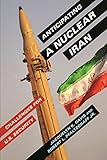Anticipating a Nuclear Iran : Challenges for U.S. Security / Robert Pfaltzgraff Jr., Jacquelyn Davis.
Material type: TextPublisher: New York, NY : Columbia University Press, [2013]Copyright date: ©2013Description: 1 online resource (240 p.) : ‹B›Charts: ‹/B›3Content type:
TextPublisher: New York, NY : Columbia University Press, [2013]Copyright date: ©2013Description: 1 online resource (240 p.) : ‹B›Charts: ‹/B›3Content type: - 9780231166225
- 9780231535946
- 355.0 23
- UA853.I7 .D38 2013
- UA853.I7 .D38 2013eb
- online - DeGruyter
- Issued also in print.
| Item type | Current library | Call number | URL | Status | Notes | Barcode | |
|---|---|---|---|---|---|---|---|
 eBook
eBook
|
Biblioteca "Angelicum" Pont. Univ. S.Tommaso d'Aquino Nuvola online | online - DeGruyter (Browse shelf(Opens below)) | Online access | Not for loan (Accesso limitato) | Accesso per gli utenti autorizzati / Access for authorized users | (dgr)9780231535946 |
Frontmatter -- CONTENTS -- TABLES AND BOXES -- PREFACE -- 1. Introduction: Setting the Scene for Iran's Emergence as a Nuclear Power -- 2. The Deterrence Dynamics of an Iran with Nuclear Weapons -- 3. Considerations Influencing Iran's Nuclear Emergence -- 4. Nuclear Weapons Operationalization: What Type of Nuclear Force? -- 5. Implications for U.S. Strategic and Operational Planning -- 6. U.S. Deterrence Planning in the Event of an Iranian Nuclear Breakout -- 7. Dealing with a Nuclear Iran and Asymmetric Challenges -- 8. U.S. Deterrence Planning and Iran -- NOTES -- INDEX
restricted access online access with authorization star
http://purl.org/coar/access_right/c_16ec
This volume is based on the assumption that Iran will soon obtain nuclear weapons, and Jacquelyn K. Davis and Robert L. Pfaltzgraff Jr. develop alternative models for assessing the challenges of a nuclear Iran for U.S. security. Through three scenario models, the book explores the political, strategic, and operational challenges facing the United States in a post-Cold War world. The authors concentrate on the type of nuclear capability Iran might develop; the conditions under which Iran might resort to threatened or actual weapons use; the extent to which Iran's military strategy and declaratory policy might embolden Iran and its proxies to pursue more aggressive policies in the region and vis-à-vis the United States; and Iran's ability to transfer nuclear materials to others within and outside the region, possibly sparking a nuclear cascade. Drawing on recent post-Cold War deterrence theory, the authors consider Iran's nuclear ambitions as they relate to its foreign policy objectives, domestic politics, and role in the Islamic world, and they suggest specific approaches to improve U.S. defense and deterrence planning.
Issued also in print.
Mode of access: Internet via World Wide Web.
In English.
Description based on online resource; title from PDF title page (publisher's Web site, viewed 02. Mrz 2022)


